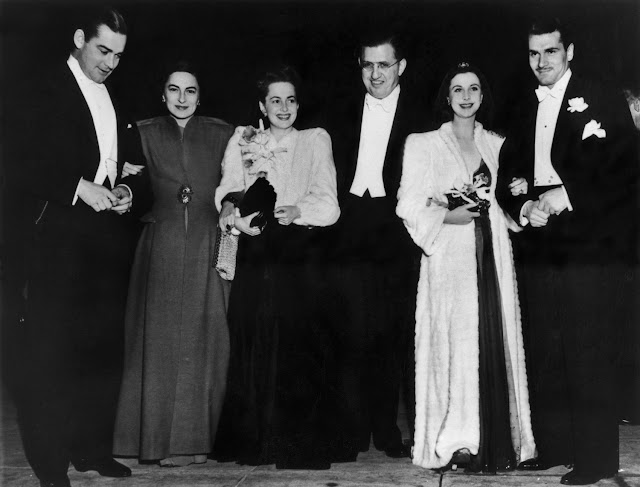Vivien Leigh arrived for the ceremony with David Selznick, Laurence Olivier, Olivia de Havilland and Jock Whitney. Both Vivien and Olivia chose to wear ermine coats over their Oscar dresses: Vivien went with a floor length coat, while Olivia chose to wear a shorter, cropped version.
Beneath her fur coat, Vivien wore a stunning, floor-length gown by Irene. Irene Lentz was a fashion designer, whose salon was located inside the Bullocks-Wilshire department store. In addition to designing costumes for the movies, Irene also designed for private customers, which included many of Hollywood's top stars such as Carole Lombard, Marlene Dietrich, Claudette Colbert and Loretta Young.
On August 25th, Irene held a fashion show for her 1939, Early Fall Collection. The gown Vivien chose for the Oscars was listed as item number fourteen with the simple description of red poppy evening gown. The green printed chiffon dress featured the aforementioned red poppies with hints of yellow, gray and blue mixed into the gown's color palette. Vivien won the Best Actress Oscar for her role of Scarlett O'Hara in Gone With the Wind.
Vivien's chiffon gown featured spaghetti straps, side cut-outs and a low-cut bodice. Her topaz pendant, set in yellow gold, hung from a slender chain around her neck, drawing attention to the deep V of the dress. Vivien chose costume jewelry to complete her look, a bracelet and large ring, to match the tone set by the pendant.
Olivia de Havilland, a nominee for Best Supporting Actress, wore a cropped ermine jacket over her floor-length evening gown. Unfortunately, as with the Atlanta and Hollywood Gone With the Wind premieres, I wasn't able to find a full length image of Olivia in her gown.
Laurence Olivier gives her a helping hand as she makes her way up the stairs and we can see the bottom half of her dress. Olivia's gown featured alternating bands of black lace and black taffeta, from her bow-topped bodice to the bottom of her wide skirt.
Hattie McDaniel arrived wearing a short fur jacket over her gown, which she highlighted with a gorgeous corsage of gardenias. She chose to wear a blue crepe gown for the night's festivities, which featured a long-sleeved, cropped jacket over her shirred bodice, with a cummerbund setting off the long skirt. Gardenias and a headband adorned her hair as she took home the Oscar for Best Supporting Actress.
Joan Bennett arrived in a white crepe evening gown on the arm of her new husband, Walter Wanger, a nominee for Outstanding Production for the movie, Stagecoach. Joan's long-sleeved gown featured a plunging neckline, which she highlighted with an emerald brooch set within a circle of diamonds and a pearl necklace. One of the biggest fashion trends of 1940, for ladies, were turbans. Joan embraced this latest fad by elegantly swathing her hair in white crepe, which matched her dress.
Though Bette Davis had already heard she wasn't going to be the night's winner for Best Actress for Dark Victory, she still showed up dressed to kill. Her escort for the night was her cousin, Johnny Favour.
Bette's black, sheer net dress came with long-sleeves and a floor-length, full skirt. Her fitted bodice featured multi-colored sequins in a very decorative motif. Her dress may have been designed by Orry-Kelly, the fashion designer for Warner Brothers.
Hedy Lamarr arrived with her husband, Gene Markey, in a long, black wool, evening cape, gorgeously studded with sequins across the shoulders, achieving a capelet effect.
The above studio portrait gives us a close-up of Hedy in her black cape, showing off the beaded design. Beneath the cape, Hedy wore a pinkish colored, long-sleeved satin gown with a fitted bodice. The dress featured a design of black velvet applique and front buttons.
Judy Garland took home a special Oscar for her outstanding performance as a screen juvenile during the past year and received a miniature statuette. I love the clasps on her fur jacket.
She wore a short-sleeved dress of blue chiffon, with a long skirt ribbed with bands of matching blue lace. She completed her look with elbow-length gloves and a corsage. Judy performed what many people think of today as her feature song, Over the Rainbow, from The Wizard of Oz.
Norma Shearer's strapless gown was designed by Balenciaga, which according to one source, had been specifically made for her while on a trip to Paris. The princess cut dress of blue satin featured an embroidered design from top to bottom and a corseted waist. Norma's jewelry consisted of a diamond necklace and several diamond bracelets on her left wrist. Her date for the evening was the handsome George Raft.
What's fun to note is that this is the same evening dress she wore just two months earlier to the Hollywood premiere of Gone With the Wind. Go, Norma! I can't imagine any of today's actresses wearing the same dress to two high profile events within months of each other.
 |
| Norma Shearer and George Raft at the GWTW premiere. |
Thanks for joining me for today's Fashion Friday post!
P.S. You might also enjoy the following:
15 Things About "Gone With the Wind" and the Oscars
11 Things About Vivien Leigh & the Oscars


























































